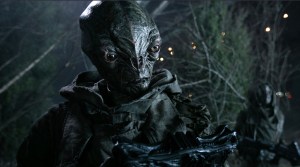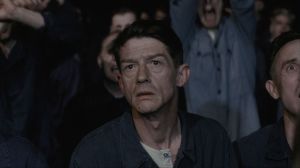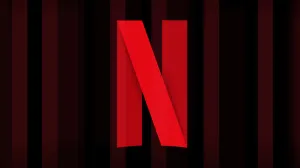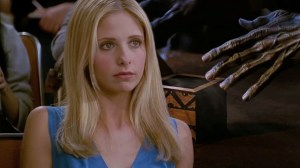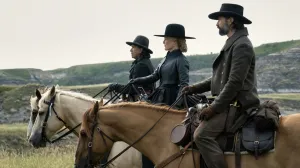
Empress #1, the newest Millarworld series, premieres this week at comic stores everywhere and on digital platforms like Comixology. It tells the story of Emporia the wife of a high-tech dictator in Earth’s ancient past who’s fleeing her husband in order to protect their children and escape the violence of his reign. We’ve had a chance to take a look at the first two issues and they are a splendid combination of a new, beautifully presented science fiction universe, stunning action sequences, and compelling family drama striking at universal themes. That’s no surprise coming from this creative team though.
Videos by ComicBook.com
Every person contributing to Empress is a modern comics all-star, and we had the opportunity to speak to each of them at ComicBook.Com. Follow along as we ask 10 questions to everyone who helped make this stunning new debut what it was, finding out how it came to be and what to expect next.
Peter Doherty – Designer and Letterer
1. Would you care to describe what your role as designer on Empress, in addition to being the letterer, entails?
Peter Doherty: It’s mainly the look of the pages that aren’t the actual story. I designed the look of the covers and the credits page to compliment the imagery of the story, although I should point out that the logo itself is Stuart’s design which gave me another element to corral my thoughts around.
For each cover I pick a colour scheme and sometimes slightly alter the way the credits are presented, mostly they’re in a block placed symmetrically at the bottom of the cover, but Stuart’s issue 1 painted variant had a large space on the bottom right and using the normal arrangement covered up part the sole figure on the cover, which looked awkward, so I rejigged the credits into a stacked design which worked better with the image.
I also did the new editorial design which runs across all the Millarworld books. Mark wanted something more modern feeling than the previous back page material, and I think the new design fits well with the look of Empress too, coincidentally.
With both jobs the idea is to present a consistent feel that presents information in an attractive and easily readable fashion.
Then I put the whole thing together with the story pages.2. When did you come on board the Empress team and what attracted you to the concept?
Doherty: Mark asked me around Christmas last year. As well as it looking like a fun project, I’ve worked with Mark for quite a while and he’s pretty easy to work with, and I knew the book was being drawn by Stuart, who’s work I’ve admired for a long time, so it was a bit of a no-brainer saying yes!
3. What motifs and visual elements stood out to you as being important to incorporate in the design of the front and back cover, credits page, and other elements of the finished comic?
Doherty: As I say, Stuart designed the logo, which has the diamond motif from the story, it was my job to compliment that in the choice of typeface and layout for the rest of the design. As he has a clean, modern feeling style and the story is sharp-edged sci-fi/space opera, it needed to have a clean feel with some open space.
I think the design work needs to be almost invisible in it’s fit with the story content, but the comic has to feel like a “whole”, like all the parts belong together.4. The back covers of the first two issues play heavily on scientific and mathematical imagery. What sort of research did you engage in to create this very real, scholarly aesthetic?
Doherty: That’s the background element Stuart drew from the painted cover variant of the relevant issue before Dave McCaig paints it!!
I mentioned to Stuart it might be a wheeze to use it on the credits page and back cover of the respective issue and he liked the idea. So that’s what I did.
Sometimes coincidence is a better ally than too much thought!!!5. With Empress #1 premiering this week, the cover will act as an advertisement to encourage readers to pick it up off the shelf. How do you aim to entice readers with the cover and other surface elements?
Doherty: Well they need to know what it’s called and who are the creators, but not so obviously that all the lovely cover art is detracted from, but complimented and framed well. You want people to pick it up–it’s back to the idea of it looking like a whole, complete and attractive product.
And this has to be done individually for each variant, picking the right colours and even coming up with a slight variation on the design, something most obvious with Skottie Young’s cover, which is much more playful than the other variants.6. Millarworld comics have a clear layout from front to back featuring lots of backmatter, reading lists, and other information. How do you aim to organize all of the content being presented in an issue of Empress in the most effective manner possible?
Doherty: It’s just finding the most appropriate and readable but also eye-catching ways to present the information that’s needed on each page. There’s usually some clear hierarchy for the different elements, the choice is how to highlight that, which isn’t always as obvious as that might sound. It’s all design work, even if it doesn’t look like it is, which is sort of the point!
For instance with the Frank Quitely interview, just by arranging the question and its respective answer together, colouring the question and answer differently then separating each into subsections with pictures, it should be clear to the reader which is the question and which is the answer and in what order they’re to be read, even without them having to consider it.7. You work directly with preparing files and making sure everything looks just right. What kind of challenges do you face in making sure what you see on your screen will look just as good on paper?
Doherty: You can never be totally confident until you see the printed product, but colour correcting your monitor is a must and of course a lot of liaison with the production people at the publishers!! Marvel do things differently to Image, with whom I’ve done production work previously, so it’s my job to make sure I fit with their production pipeline.
8. Lettering Empress you have to make decisions regarding where to cover Stuart Immonen and Wade von Grawbadger’s artwork with captions and speech bubbles. What’s your philosophy in striking a balance and making sure the art isn’t overwhelmed by what is being said?
Doherty: Richard Starkings once told me, when I asked him what he thought of my lettering, that I “stayed out of the way of the art”! That made me laugh, as he’s partly right. I don’t like to cover up too much of the important bits of the art!!
But the balloons are probably the primary visual element that is leading the reader’s eye around the page, so I do fit them in as much as possible with the storytelling and the compositional flow of the artwork. It’s one of the reasons I use such long balloon tails, I can point the eye in particular directions highlighting compositional rhythms or frame the action in subtle little ways.9. Are there ever times when the script might need tweaking to ensure the letters and visuals work better in the finished issue?
Doherty: I usually letter the story quite early on so there is time to tweak the script, and in some cases, the art too for a smoother overall story. The Empress team is very much ego-free on that count, the aim is to do the best comic possible not be individual show-offs, and lettering the issues early on lets everyone get a feel for how the art and script play off each other.
10. Could you share one particular design element from the first issue with our audience and explain the process that went into crafting it?
Doherty: Here’s some stages in the cover design.


1 & 2 were attempts to have a string of credits above the logo but even in differing weights it still reads as a long line of names where none stand out very much, and with a creator-owned book like Empress the main creators need to be prominent.

3 recreates the general look of creator credits one finds on most company books these days. Again this suffers from the lack of prominence given to the main creators.


4 & 5: I thought balancing the logo with a creator credit at the bottom of the cover might work well, and it does create a good visual balance but using everyone’s full names, there’s too much to read, so we settled with design with only surnames, which had another advantage with Mark and Stuart’s name standing out more obviously.

5 was the version that was going to be used until everyone saw the ad I was asked to put together (6-AD). As it’s an ad, and not a cover, I figured using full names and making them much larger than would be acceptable on a cover was the point, you want an ad to have immediate impact and readability. Here we have the main creators full names but the surnames stand out more, hopefully these and the book’s title are the main things the viewer notices.


Everyone seemed to like this arrangement so I did a slightly more smaller version for the cover design (7) and I moved the logo nearer to the top edge of the cover as the space wasn’t needed for anything else, and then 8 is the final finessed colour job combined with the full trade dress.Empress is available April 6, 2016 from physical and digital retailers of comics.
Check Out More Interviews From Empress Week Below:

